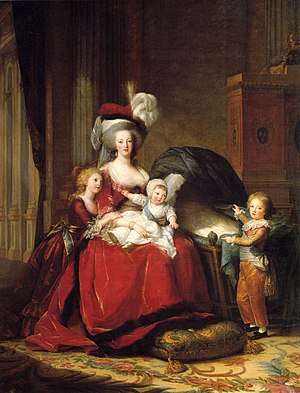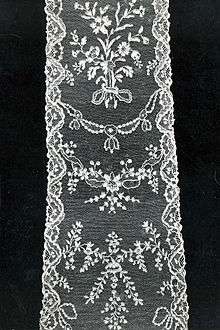Alençon lace
Alençon lace (UK: /ˈælənsɒn, æˈlɒ̃sɒ̃/,[1] US: /əˈlɛnsɒn, -sən/)[2][3] or point d'Alençon (French: [pwɛ̃ dalɑ̃sɔ̃]) is a needle lace that originated in Alençon, France. It is sometimes called the "Queen of lace." Lace making began in Alençon during the 16th century and the local industry was rapidly expanded during the reign of Louis XIV by Jean-Baptiste Colbert, who established a Royal Workshop in the town to produce lace in the Venetian style in 1665. The purpose of establishing this workshop was to reduce the French court's dependence on expensive foreign imports. Marthe La Perrière had modified the Venetian technique and Alençon emerged as a unique style around 1675 after Colbert's monopoly ended.

Versailles, Musée national du Château et des Trianons
History
Though the demand for lace went into sharp decline following the French Revolution, it recovered some of its popularity during the Second French Empire. St.Marie-Azélie Guérin Martin,[4] the mother of St. Therese[5] of Lisieux was a famous lace-maker at Alençon. It entered terminal decline at the end of the 19th century with changes in fashion and the development of cheaper, machine-made lace.

Dino making survived on a small scale and the technique was preserved by Carmelite nuns in Alençon. In 1976 a National Lace Workshop was established in the town to ensure that this lace-making technique survives. There is a permanent exhibition of lace and a display showing how it is made in the Musée des Beaux Arts et de la Dentelle, located in the town centre and adjoining the Workshop. The workshops themselves are open to the public only on certain days of the year.
UNESCO recognised the unusual craftsmanship of this lace and added it to its Representative List of the Intangible Cultural Heritage of Humanity[6] in November 2010.
Bibliography
- Despierres, Gérasime Bonnaire (1987). Alençon lace. Aberdeen: Aberdeen University Press. p. 207. ISBN 978-0-08-034512-3.
- Duval, Louis (1883). Documents pour servir à l'histoire de la fabrication du point d'Alençon (in French). Alençon: E. Renaut-de Broise. p. 108.
Notes
- "Alençon". Lexico UK Dictionary. Oxford University Press. Retrieved 29 July 2019.
- "Alençon". Collins English Dictionary. HarperCollins. Retrieved 29 July 2019.
- "alençon". Merriam-Webster Dictionary. Retrieved 29 July 2019.
- Shrine Louis and Zelie Martin (Alençon-France) - Zelie Martin's life Archived 2014-03-15 at the Wayback Machine
- Shrine Louis and Zelie Martin (Alençon-France) - St. Therese's life Archived 2014-03-15 at the Wayback Machine
- "Representative List of the Intangible Cultural Heritage". Retrieved 21 November 2010.
External links
| Wikimedia Commons has media related to Point d'Alençon. |
